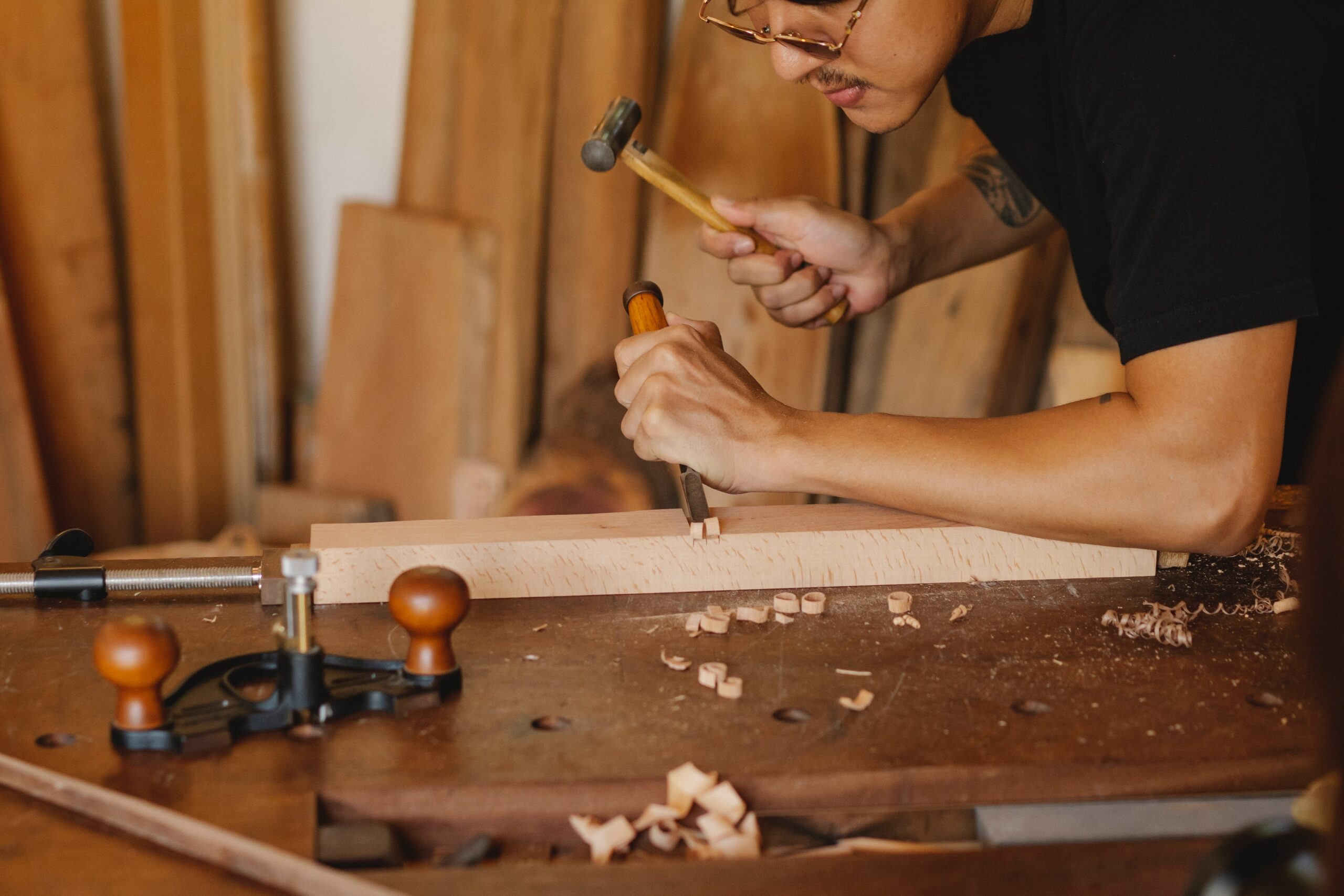The word “joinery” refers to a wide range of exquisite woodworking. The more you know about wood joinery, the better, whether you’re a hobbyist, professional, or just interested in learning about the many kinds of woodworking joints so you may work on a do-it-yourself project at home.
A joint is used in woodworking to link two pieces of wood together. Even a novice can utilize some joints since they are simple connections. Others are a little trickier to deal with, let alone make, because they require interlocking slots.
The term refers to the process of physically attaching wood parts together using a variety of methods, most commonly requiring the creation of exact fit notches in the wood, molding that is heated and under pressure, and finishing. This involves assembly work for benches that was nearly fully carried out in a workshop.
Many types of joints have been in use for decades or even millennia since wood joints are crucial to woodworking. Woodworking is an age-old skill that has endured because it uses one of nature’s most adaptable materials—wood—to create both artistic and utilitarian objects. Ancient Egyptian and Chinese carpenters and artisans contributed to the development of joinery techniques that are still used by woodworkers and builders today.
Every joint has a definite function, from basic, functional connections to elaborate, exquisite designs that highlight the woodworker’s expertise and artistry.
In woodworking tasks, these wood joints are essential since they dictate the finished piece’s strength, stability, and overall beauty. Knowing the many types of wood joints enables woodworkers to choose the best joint for each job, ensuring that the final result satisfies the required specifications.
Brief overview of wood joinery techniques
Several woodworking techniques are available to attach two pieces of wood together. Some techniques employ fasteners like nails or screws to hold them in place, while others entail cutting channels into two separate wood pieces so that they lock together. Mortise and tenon, dovetail, lap, and half joint are some traditional ways of wood joinery techniques. An incredibly strong connection is produced by combining long grain to long grain connections with wood glue that penetrates deeply into the timber.
Traditional wood joinery methods frequently avoid using adhesives or mechanical fasteners by making advantage of the unique material qualities of wood. While wood joinery traditions exist in every culture where pieces of wood are combined to create furniture or constructions, they are particularly well-documented and revered in the Indian, Chinese, European, and Japanese cultures.
Furniture from the first few dynasties demonstrates the usage of intricate joints, such the Dovetail, over 5,000 years ago because to the actual existence of Indian and Egyptian pieces. This custom persisted in later Western designs.
Though Eastern civilizations did not try to “hide” their joints, Western practices concentrated on hiding joinery. Particularly in Chinese and Japanese customs, hundreds of different types of joints were necessary. The cause was that much of Central and Southeast Asia’s highly variable temperatures and muggy weather did not lend well to the nails and glues that were utilized. Furthermore, contemporary glues do not adhere well to the extremely resinous timbers used in traditional Chinese furniture, even after they have been cleaned with solvents.
Importance of mastering advanced methods
Across the globe, wood is the material most frequently used to create furniture. Its foundations include numerous customs and cultural value. Traditional construction methods are gradually fading from daily use. Despite being an inspiration for designers, painters, and architects. One of the most well-known methods that has kept structures standing for millennia with little more than tension and friction is the skill of wood joinery. Simplistic wood joineries were utilized long before screws and metal fasteners were commonplace. grasp furniture design requires a grasp of wooden joinery processes.
An essential part of any woodworking project are the joints. Wood joinery is essential to creating high-quality work because it enables cabinetmakers to put various parts of a piece together into an aesthetically beautiful and structurally sound whole. The diversity of joinery gives alternatives for choosing the best joinery for a certain project while considering the tools, level of ability, and time required to make joints.
The strength and beauty of wood joinery are important. In woodworking, joinery fulfills a dual function by guaranteeing the piece’s structural soundness and enhancing its overall aesthetic appeal. A well-made joint not only firmly binds the wood together but also improves the creation’s aesthetic appeal. Joinery flaws can result in unstable constructions, shaky furniture, and shorter lifespans.
Wood is anisotropic, meaning that its material qualities vary in different dimensions. This must be taken into consideration when joining wood components together, otherwise the connection would eventually fail. Many wood joinery techniques either rely on this fact or compensate for it. Split boards or fractured joints are frequently the result of gluing boards with the grain running perpendicular to each other. Despite being created by skilled artisans, some 18th-century furniture did not take this into consideration. The ultimate result is a magnificent piece of craftsmanship, albeit it may have broken bracket feet since they were sometimes joined using bonded blocks that ran perpendicular to the foundation sections. Because the glue blocks were nailed and glue-fastened, the parts did not expand and shrink equally. Additionally, because broad boards were widely accessible and in use at the time, this led to their splitting.
It is much more crucial in modern woodworking since heating and air conditioning increase the demands on the environment’s ability to breathe and the fibers inside the wood. All joints used in woodworking must account for these modifications and accommodate the ensuing movement. Each species of wood has a typical respiration rate, and it is commonly believed that a board needs one year per inch of thickness to become acclimated to its environment. When processing raw wood for use as furniture or construction, it is necessary to take into consideration variations in the wood’s size, uneven breathing, and checking or cracking.
Introduction to Mortise and Tenon joinery
The strongest and most traditional form of joint used in woodworking is the mortise and tenon joint. A mortise and a tenon are its two separate constituent pieces. It is typically employed to create a 90-degree angle between two pieces of wood. Due to its strength and elegant look, this kind of joint has been utilized by artisans for ages. These days, it’s one of the most often used joints in woodworking for building beds, tables, chairs, cabinets, doors, windows, and panels. Mortise and tenon joints, however, need very fine workmanship to function well in any type of construction.
It’s evident that this joint is among the most adaptable out there. They are also a very effective component of a construction since they are extremely robust and well-tested. Mortise and tenon joints are typically utilized for frames, much to how dovetail joints are preferred for drawer fronts because to their resistance to being pushed apart. They are preferred for products like windows, doors, beds, and tables because of their tensile strength because these frequently require a solid frame and wood to be attached at a 90-degree angle. In these situations, the mortise and tenon connection provides such a secure join that it is essential to the furniture’s lifespan.
This joint may be thought of as a “insert tab A into slot B” connection for the sake of simplicity. The tenon is a tab that is slightly smaller than the original size of the inserted material, whereas the mortise is a groove cut into the receiving material. Because of the decrease, the tenon has a shoulder that adds to its stability in all directions.
To create a connection that can be held together by friction alone or with adhesives or fasteners, the tenon must fit tightly into the mortise. While some mortise slots conceal the tenon’s end inside the mortise gap, others are open, enabling the tenon to pass through the material. Mortise and tenon joints are used in a wide range of undertakings, from exquisite furniture construction to rustic carpentry.
Here’s an overview of the four most common variations of mortise and tenon joints:
Blind joint: Likewise referred to as a “stub” or “hidden” joint. In this instance, the mortise does not completely penetrate the mortised substance. As a result, the tenon’s end grain is hidden and has a pocket to rest in.
Through joint: On the other hand, a “through” or “open” joint has a mortise that, like a needle’s eye, goes all the way through the material. This permits the tenon to either extend past or finish flush with the mortised material’s exterior face.
Wedged tenon: By extending the tenon’s end through the mortise, certain mortise-and-tenon joints give strength. The exterior face of the mortise is carved to accept the dovetail form that these wedges provide the tenon. The wedges can be bonded to both of the tenon’s edges or put in kerfs that are carved into the tenon.
Tusked tenon: This kind of through tenon was common in ancient times and is still utilized in some modern furniture designs. A hole placed to the side of the tenon receives a wedge or pin, and the tenon extends past the end of the mortise material. This keeps the tenon from falling out by acting as a cotter pin.

